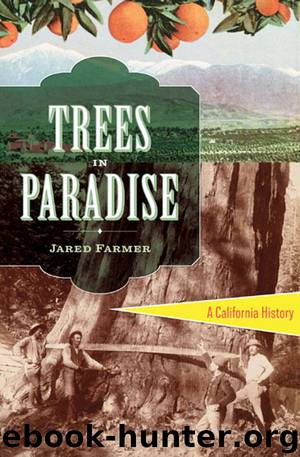Trees in Paradise by Jared Farmer

Author:Jared Farmer
Language: eng
Format: epub
Publisher: W. W. Norton & Company
Published: 2013-09-09T16:00:00+00:00
TO SMUDGE OR NOT TO SMUDGE
Frost was the dirty little secret of Southland citriculture. No self-respecting booster of the region would outright admit to freezing weather. Every realtor and orchardist claimed that his property lay within the frost-free zone. Land agents advertised “frostless” slopes in the foothills of the Transverse Ranges where cold air supposedly never settled. Whole citrus districts advertised themselves as frost-proof. An extension agent with the University of California remarked in 1899 that the frost line was “quite provokingly flexible.”16 After freezing spells, boosters minimized local losses while exaggerating losses in rival districts.
Coastal Southern California experiences two kinds of cold spells, advective freezes and radiation frosts. In the first, less common case, a large Arctic air mass sweeps down from Canada, into the Great Basin, and over the rim of the Mojave Desert. Some old-timers referred to this kind of cold front as a “Mormon wind.” More commonly, the Southland undergoes atmospheric inversion: a low ceiling of warm air in the atmosphere prevents the heavier, colder air on the surface from rising. During radiation frosts, the sky is clear, the wind calm, the humidity low. By rule of thumb, the critical temperature for “citrus pneumonia” is 26° F, though it varies by varietal. Oranges are hardier than lemons, which are hardier than limes. Two consecutive cold winters in 1878 through 1880 destroyed the state’s incipient lime industry. One locale or another—so-called frost pockets—drops below freezing every winter in Southern California. Regionwide freezes are less frequent but hardly rare. It is a calculated gamble to grow citrus under such conditions. “The navel orange reaches its perfection of color and flavor only where the days are bright and hot and the nights are cold,” explained a Redlands historian. “Like genius and insanity, the margin between success and disaster is narrow and fraught with mischance. Even while the oranges are reaching their acme of tang and color they are at the same time flirting with disaster.”17
For fighting Jack Frost, orchardists exercise three basic strategies: retain heat, move the cold air, or replace lost heat. Retention requires some kind of barrier to the frigid air. Early citrus ranchers wrapped cornstalks, palm fronds, tule reeds, newspaper, or tarpaper around the trunks of young trees for insulation. But this did nothing to protect fruit. Hoping to diminish the loss of surface heat, growers experimented with temporary or permanent outdoor roofs—propped-up latticework—made of laths, muslin, or burlap. This technique worked best at nurseries with low-height seedbed stock. Occasionally wealthy orchardists installed laths over their full-height trees. Tall and thick windbreaks—typically Tasmanian blue gums alternated with Monterey cypresses—were common yet controversial. Experts disagreed as to whether shelterbelts blocked cold air or trapped it, preventing proper air drainage.
The second strategy, moving cold air—or, more precisely, circulating the warmer upper layer of an inversion into the colder underlayer—requires elevated outdoor propeller fans. Technologically and financially, this solution remained out of reach until the second half of the twentieth century. From the 1890s through the 1950s, orange and lemon growers in Southern California focused on the third strategy: replacement heat.
Download
This site does not store any files on its server. We only index and link to content provided by other sites. Please contact the content providers to delete copyright contents if any and email us, we'll remove relevant links or contents immediately.
| Cacti & Succulents | Flowers |
| Mushrooms | Trees |
Sapiens: A Brief History of Humankind by Yuval Noah Harari(14308)
The Tidewater Tales by John Barth(12623)
Mastermind: How to Think Like Sherlock Holmes by Maria Konnikova(7272)
Do No Harm Stories of Life, Death and Brain Surgery by Henry Marsh(6903)
The Thirst by Nesbo Jo(6871)
Why We Sleep: Unlocking the Power of Sleep and Dreams by Matthew Walker(6648)
Life 3.0: Being Human in the Age of Artificial Intelligence by Tegmark Max(5504)
Sapiens by Yuval Noah Harari(5316)
The Longevity Diet by Valter Longo(5036)
The Body: A Guide for Occupants by Bill Bryson(5022)
The Rules Do Not Apply by Ariel Levy(4904)
The Immortal Life of Henrietta Lacks by Rebecca Skloot(4546)
Animal Frequency by Melissa Alvarez(4422)
Why We Sleep by Matthew Walker(4388)
The Hacking of the American Mind by Robert H. Lustig(4333)
Yoga Anatomy by Kaminoff Leslie(4329)
All Creatures Great and Small by James Herriot(4266)
Double Down (Diary of a Wimpy Kid Book 11) by Jeff Kinney(4237)
Embedded Programming with Modern C++ Cookbook by Igor Viarheichyk(4134)
